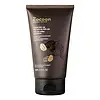What's inside
What's inside
 Key Ingredients
Key Ingredients

 Benefits
Benefits

 Concerns
Concerns

 Ingredients Side-by-side
Ingredients Side-by-side

Water
Skin ConditioningPotassium Laureth Phosphate
EmulsifyingCocamidopropyl Betaine
CleansingAcrylates/Steareth-20 Methacrylate Copolymer
Sodium Cocoyl Glycinate
CleansingCocoyl Methyl Glucamide
Skin ConditioningPEG-7 Glyceryl Cocoate
EmulsifyingGlycerin
HumectantBenincasa Cerifera Fruit Extract
Skin ConditioningSalicylic Acid
MaskingNiacinamide
SmoothingPanthenol
Skin ConditioningCentella Asiatica Extract
CleansingBetaine
HumectantPropanediol
SolventButylene Glycol
HumectantPEG-120 Methyl Glucose Dioleate
EmulsifyingMolasses
Skin ConditioningGlycereth-26
HumectantSodium Lactate
BufferingSodium Hydroxide
BufferingPolysorbate 20
EmulsifyingMelaleuca Alternifolia Leaf Oil
AntioxidantRosmarinus Officinalis Leaf Oil
MaskingLavandula Angustifolia Flower Oil
MaskingAllantoin
Skin ConditioningEthylhexylglycerin
Skin ConditioningPhenoxyethanol
PreservativeXanthan Gum
EmulsifyingMenthyl Lactate
MaskingTrisodium Ethylenediamine Disuccinate
Water, Potassium Laureth Phosphate, Cocamidopropyl Betaine, Acrylates/Steareth-20 Methacrylate Copolymer, Sodium Cocoyl Glycinate, Cocoyl Methyl Glucamide, PEG-7 Glyceryl Cocoate, Glycerin, Benincasa Cerifera Fruit Extract, Salicylic Acid, Niacinamide, Panthenol, Centella Asiatica Extract, Betaine, Propanediol, Butylene Glycol, PEG-120 Methyl Glucose Dioleate, Molasses, Glycereth-26, Sodium Lactate, Sodium Hydroxide, Polysorbate 20, Melaleuca Alternifolia Leaf Oil, Rosmarinus Officinalis Leaf Oil, Lavandula Angustifolia Flower Oil, Allantoin, Ethylhexylglycerin, Phenoxyethanol, Xanthan Gum, Menthyl Lactate, Trisodium Ethylenediamine Disuccinate
Water
Skin ConditioningCoffea Arabica Seed Powder
AbrasiveCetearyl Alcohol
EmollientCocamidopropyl Betaine
CleansingCarthamus Tinctorius Seed Oil
MaskingGlyceryl Stearate
EmollientC15-19 Alkane
SolventGlycerin
HumectantCeteareth-20
CleansingCeteareth-12
EmulsifyingTheobroma Cacao Seed Butter
EmollientButyrospermum Parkii Butter
Skin ConditioningC10-18 Triglycerides
EmollientOlus Oil
EmollientCetyl Palmitate
EmollientGlycine Soja Sterols
EmollientPhospholipids
Skin ConditioningGlycolipids
Skin ConditioningHydroxypropyl Starch Phosphate
Glycine Soja Oil
EmollientSodium Stearoyl Glutamate
CleansingAcrylates/C10-30 Alkyl Acrylate Crosspolymer
Emulsion StabilisingTocopherol
AntioxidantXanthan Gum
EmulsifyingPhenoxyethanol
PreservativeSodium Hydroxide
BufferingEthylhexylglycerin
Skin ConditioningTrisodium Ethylenediamine Disuccinate
Water, Coffea Arabica Seed Powder, Cetearyl Alcohol, Cocamidopropyl Betaine, Carthamus Tinctorius Seed Oil, Glyceryl Stearate, C15-19 Alkane, Glycerin, Ceteareth-20, Ceteareth-12, Theobroma Cacao Seed Butter, Butyrospermum Parkii Butter, C10-18 Triglycerides, Olus Oil, Cetyl Palmitate, Glycine Soja Sterols, Phospholipids, Glycolipids, Hydroxypropyl Starch Phosphate, Glycine Soja Oil, Sodium Stearoyl Glutamate, Acrylates/C10-30 Alkyl Acrylate Crosspolymer, Tocopherol, Xanthan Gum, Phenoxyethanol, Sodium Hydroxide, Ethylhexylglycerin, Trisodium Ethylenediamine Disuccinate
Ingredients Explained
These ingredients are found in both products.
Ingredients higher up in an ingredient list are typically present in a larger amount.
Cocamidopropyl Betaine is a fatty acid created by mixing similar compounds in coconut oil and dimethylaminopropylamine, a compound with two amino groups.
This ingredient is a surfactant and cleanser. It helps gather the dirt, pollutants, and other impurities in your skin to be washed away. It also helps thicken a product and make the texture more creamy.
Being created from coconut oil means Cocamidopropyl Betaine is hydrating for the skin.
While Cocamidopropyl Betaine was believed to be an allergen, a study from 2012 disproved this. It found two compounds in unpure Cocamidopropyl Betaine to be the irritants: aminoamide and 3-dimethylaminopropylamine. High-grade and pure Cocamidopropyl Betaine did not induce allergic reactions during this study.
Learn more about Cocamidopropyl BetaineEthylhexylglycerin (we can't pronounce this either) is commonly used as a preservative and skin softener. It is derived from glyceryl.
You might see Ethylhexylglycerin often paired with other preservatives such as phenoxyethanol. Ethylhexylglycerin has been found to increase the effectiveness of these other preservatives.
Glycerin is already naturally found in your skin. It helps moisturize and protect your skin.
A study from 2016 found glycerin to be more effective as a humectant than AHAs and hyaluronic acid.
As a humectant, it helps the skin stay hydrated by pulling moisture to your skin. The low molecular weight of glycerin allows it to pull moisture into the deeper layers of your skin.
Hydrated skin improves your skin barrier; Your skin barrier helps protect against irritants and bacteria.
Glycerin has also been found to have antimicrobial and antiviral properties. Due to these properties, glycerin is often used in wound and burn treatments.
In cosmetics, glycerin is usually derived from plants such as soybean or palm. However, it can also be sourced from animals, such as tallow or animal fat.
This ingredient is organic, colorless, odorless, and non-toxic.
Glycerin is the name for this ingredient in American English. British English uses Glycerol/Glycerine.
Learn more about GlycerinPhenoxyethanol is a preservative that has germicide, antimicrobial, and aromatic properties. Studies show that phenoxyethanol can prevent microbial growth. By itself, it has a scent that is similar to that of a rose.
It's often used in formulations along with Caprylyl Glycol to preserve the shelf life of products.
Sodium Hydroxide is also known as lye or caustic soda. It is used to adjust the pH of products; many ingredients require a specific pH to be effective.
In small amounts, sodium hydroxide is considered safe to use. However, large amounts may cause chemical burns due to its high alkaline.
Your skin has a natural pH and acid mantle. This acid mantle helps prevent harmful bacteria from breaking through. The acid mantle also helps keep your skin hydrated.
"Alkaline" refers to a high pH level. A low pH level would be considered acidic.
Learn more about Sodium HydroxideTrisodium Ethylenediamine Disuccinate is used to help stabilize a product.
It is a chelating agent, meaning it helps prevent metal ions from binding to other ingredients. This prevents unwanted reactions in products. Metal ions can come into a product via the water ingredient. They are found in trace amounts and are not known to be harmful.
Water. It's the most common cosmetic ingredient of all. You'll usually see it at the top of ingredient lists, meaning that it makes up the largest part of the product.
So why is it so popular? Water most often acts as a solvent - this means that it helps dissolve other ingredients into the formulation.
You'll also recognize water as that liquid we all need to stay alive. If you see this, drink a glass of water. Stay hydrated!
Learn more about WaterXanthan gum is used as a stabilizer and thickener within cosmetic products. It helps give products a sticky, thick feeling - preventing them from being too runny.
On the technical side of things, xanthan gum is a polysaccharide - a combination consisting of multiple sugar molecules bonded together.
Xanthan gum is a pretty common and great ingredient. It is a natural, non-toxic, non-irritating ingredient that is also commonly used in food products.
Learn more about Xanthan Gum